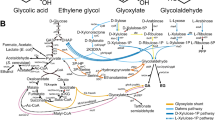Summary
The enzymatic oxidation of 1,2-cyclohexanediol and related substrates by Gluconobacter oxydans (ATCC 621) was investigated. At low pH, membrane-bound enzymes were active and at high pH, NAD-dependent, soluble enzymes showed activity. Whole bacterial cells were used to catalyze some bioconversions. Racemic trans-1,2-cyclohexanediol was oxidized at pH 3.5 to give (R)-2-hydroxycyclohexanone (96% e.e.) and at pH 8.0 the same substrate was oxidized to (S)-2-hydroxycyclohexanone (97% e.e.). The latter conversion was severely inhibited by the reaction product while the former was not significantly product inhibited. (S)-2-hydroxycyclohexanone (97% e.e.) was also prepared from cis-1,2-cyclohexanediol by oxidation with G. oxydans cells at pH 3.5 in a reaction which continued to 100% conversion.
Similar content being viewed by others

References
Ameyama M, Shinagawa E, Matsushita K, Adachi O (1985) Solubilization, purification and properties of membranebound glycerol dehydrogenase from Gluconobacter industrius. Agric Biol Chem 49:1001–1010
Asai T (1968) Acetic acid bacteria; Classification and biochemical activities. University of Tokyo Press
Dale JA, Dull DL, Mosher HS (1969) α-Methoxy-α-trifluoromethylphenylacetic acid, a versatile reagent for the determination of enantiomeric composition of alcohols and amines. J Org Chem 34:2543–2549
Davis (1964) Disc electrophoresis II. Method and application to human serum proteins. Ann N Y Acad Sci 121:404–427
Fulmer EI, Underkofler LA, Bantz AC (1943) The production of acetylmethylcarbinol by the action of Acetobacter suboxydans upon 2,3-butylene glycol. J Am Chem Soc 65:1425–1427
Holst O, Enfors S-O, Mattiasson B (1982) Oxygenation of immobilized cells using hydrogen-peroxide; a model study of Gluconobacter oxydans converting glycerol to dihydroxyacetone. Eur J Appl Microbiol Biotechnol 14:64–68
Lee LG, Whitesides GM (1986) Preparation of optically active 1,2-diols and α-hydroxy ketones using glycerol dehydrogenase as catalyst: limits to enzyme-catalyzed synthesis due to noncompetitive and mixed inhibition by product. J Org Chem 51:25–36
Rapin A, Haenni AL, Posternak T (1967) Recherches sur la biochimie des cyclitols X. Sur les cyclitol-déshydrogenases d'Acetobacter suboxydans I. Helv Chim Acta 50:1801–1810
Shinagawa E, Matsushita K, Adachi O, Ameyama M (1982) Purification and characterization of d-sorbitol dehydrogenase from membrane of Gluconobacter suboxydans var. α. Agric Biol Chem 46:135–141
Ui S, Masuda H, Muraki H (1983) Stereospecific and electrophoretic natures of bacterial 2,3-butanediol dehydrogenases. J Ferment Technol 61:467–471
Wilson NAB, Read J (1935) The optically active diphenylhydroxyethylamines and isohydrobenzoins. Part VII. The 1:2cyclohexanediols and related compounds. J Chem Soc 1269–1273
Author information
Authors and Affiliations
Rights and permissions
About this article
Cite this article
Adlercreutz, P. Oxidation of trans- and cis-1,2-cyclohexanediol by Gluconobacter oxydans . Appl Microbiol Biotechnol 30, 257–263 (1989). https://doi.org/10.1007/BF00256215
Received:
Accepted:
Issue Date:
DOI: https://doi.org/10.1007/BF00256215



